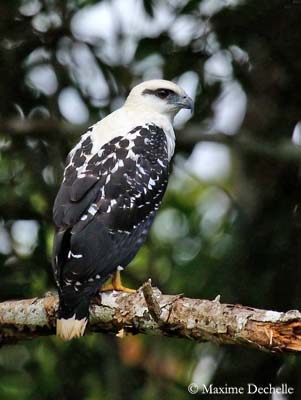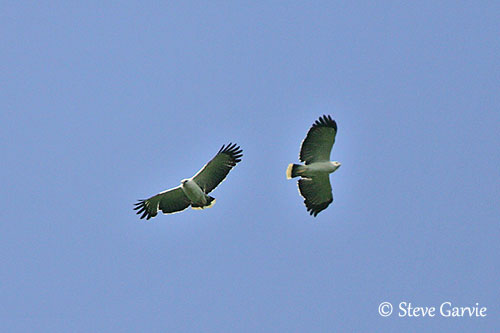
Fr: Buse blanche
Ang: White Hawk
All: Schneebussard
Esp: Busardo Blanco
Ita: Poiana bianca
Nd: Grote Bonte Buizerd
Sd: vitvråk
Photographers:
Roger Ahlman
Pbase Galleries Peru and Ecuador
Marc Chrétien
MURINUS
Maxime Dechelle
LEPAPARRAZO
Steve Garvie
RAINBIRDER Photo galleries & Flickr Rainbirder
Ken Havard
My Bird Gallery & Flickr gallery 1 & Flickr gallery 2
Text by Nicole Bouglouan
Sources:
HANDBOOK OF THE BIRDS OF THE WORLD Vol 2 by Josep del Hoyo-Andrew Elliot-Jordi Sargatal - Lynx Edicions - ISBN: 8487334156
A GUIDE TO THE BIRDS OF COLOMBIA by Steven L. Hilty and William L. Brown - Princeton University Press – ISBN 069108372X
PORTRAITS D’OISEAUX GUYANAIS - Groupe d'étude et de protection des oiseaux en Guyane (GEPOG) - Ibis rouge éditions - ISBN: 2844501842
A GUIDE TO THE BIRDS OF MEXICO AND NORTHERN CENTRAL AMERICA by Steve N. G. Howell, Sophie Webb - Oxford University Press - ISBN: 0198540124
BIRDS OF VENEZUELA by Steven L. Hilty – Ed. Christopher Helm – ISBN: 0713664185
RAPTORS OS THE WORLD by James Ferguson-Lee – Helm Field Guides – ISBN: 0713669578
The Cornell Lab of Ornithology - Birds of the World
The Online Guide to the Animals of Trinidad and Tobago
Global Raptor Information Network - Working to Conserve Birds of Prey in nature
Wikipedia, the free encyclopaedia


White Hawk
Pseudastur albicollis
Accipitriformes Order – Accipitridae Family
INTRODUCTION:
The White Hawk is found from S Mexico through Central America to NW South America, from W Colombia, Trinidad, Venezuela and the Guianas to E Colombia, E Peru, E Ecuador, Bolivia and Brazil. Four races share the wide range.
This species frequents lowlands and foothills in wet forested areas. It can be seen perched for long periods at forest edge and in clearings, in areas usually between 1,400 and 1,800 metres of elevation.
It feeds on a variety of vertebrates and invertebrates, mainly reptiles such as lizards and snakes, but young birds, amphibians, some fish and large insects are also part of its diet.
The nest is a cup-shaped platform made with sticks, placed high in tree, and the female usually lays a single egg. Both parents feed the young.
The White Hawk has a large range in which it is common, but it may be affected by deforestation and fragmentation of its forested habitat. But currently, the species is not considered globally threatened.

DESCRIPTION OF THE BIRD:
Biometrics:
Length: 46-56 cm
Weight: M: 600-670 g – F: 695-855 g
The White Hawk has very broad wings and short, broad tail.
The adult of nominate race has white plumage on most of the body, except the upperwing which is black with mottled black and white upper back. The tail is white with broad, black subterminal band.
The underparts are white with black wingtips. The flight-feathers are finely barred black.
The bill is black with dark grey cere. The eyes are brown, surrounded by a restricted black area. Legs and feet are yellow with black talons.
Male and female have similar plumage, but the female is larger than male.
The immature may show a variable amount of dark streaking, mainly on the head.

SUBSPECIES AND RANGE:
The White Hawk has four subspecies that differ mainly in plumage pattern.
P.a. ghiesbreghti (Mexican White Hawk) occurs from S Mexico to Guatemala, Belize, NW Honduras and W El Salvador.
This race is almost entirely white with yellowish-brown eyes.
P.a. costaricensis (Costa Rican White Hawk) is found from N Honduras to Panama and W Colombia.
This race has narrow black subterminal tail band. On the upperwing, flight-feathers, upper primary coverts and greater upper secondary coverts are black with white tips. Outer lesser and median upperwing coverts show some black spotting.

P.a. williaminae (Colombian White Hawk) is found in N Colombia and extreme NW Venezuela (Perijá).
This one has wings and upper back heavily scaled white. Crown, nape and hind neck are white with sparse black streaks. The tail has broad, black subterminal band.
P.a. albicollis (Amazonian White Hawk) (described above) occurs in N Venezuela (mainly coastal regions), Trinidad, S and E Venezuela and the Guianas, through Amazonia to E Colombia, E Peru, E Ecuador, N and E Bolivia and Brazil.
This race has the darkest upperparts of all subspecies.
HABITAT:
The White Hawk usually occurs in lowlands and foothills of the evergreen neotropical forests, but also in subtropical very wet areas. It frequents forest edges and pastures with isolated trees. The species is present between 1,400 and 1,800 metres of elevation throughout the large range.

CALLS AND SONGS: SOUNDS BY XENO-CANTO
The White Hawk gives a hoarse, drawn-out, whistled call « whii-ii-eeuhhr” or “hweeiiihrr…” when it is soaring.
BEHAVIOUR IN THE WILD:
The White Hawk feeds on both vertebrates and invertebrates. However, the diet includes mainly reptiles such as lizards and snakes up to 38 centimetres long, and especially Coral snakes (Micrurus fulvius) usually devoured whole. But young or weak birds, amphibians, some fish and large insects are also taken.
It hunts from perch within the forest, but it is also known to forage with groups of Capuchin monkeys or South American coatis. The hawk soars while monkeys or coatis are moving in groups through the forest, and it easily swoops down to catch the prey flushed by the passing groups.
The courtship displays start in February. This behaviour is poorly known, but the birds probably perform aerial displays. The stick nest is built in tree, up to 22-23 metres above the ground.

The White Hawk is sedentary.
This species often soars low to high over the forest, alone or in pairs. It flies with deep, floppy wingbeats, and soars on flat wings slightly pressed forwards. The tail is spread.
REPRODUCTION OF THIS SPECIES:
The White Hawk builds the nest and displays in February whereas the laying occurs in March.
The cup-shaped structure is made with sticks and branches, and green or dead leaves. It is placed high in tree, up to 22-23 metres, often in a mass of epiphytes.
The female lays a single bluish-white egg with pale brown markings over the entire surface. The incubation lasts 34-36 days and is performed by the female. The chick is fed by both parents. It fledges about 85-90 days after hatching. It depends on parents for food during an extended period of about 75-80 days.


PROTECTION / THREATS / STATUS:
The White Hawk has a large range in which it is described as common.
But this species is affected by habitat loss, caused by deforestation for agriculture and livestock expansion, and by logging of mature forests.
The population is roughly estimated to number less than 50,000 individuals. It is placed in the band 20,000/49,999 individuals. It is suspected to be declining.
However, the White Hawk is not globally threatened and currently evaluated as Least Concern.
